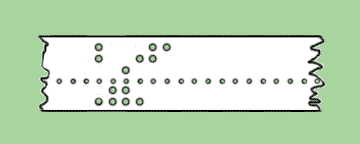| Binary |
Decimal |
| LTRS |
FIGS |
| 00000
| 0
|
| (not used)
| 00001
| 1
|
| E
| 3
|
| 00010
| 2
|
| LF
| LF
|
| 00011
| 3
|
| A
| -
|
| 00100
| 4
|
| SP
| SP
|
| 00101
| 5
|
| S
| BEL
|
| 00110
| 6
|
| I
| 8
|
| 00111
| 7
|
| U
| 7
|
| 01000
| 8
|
| CR
| CR
|
| 01001
| 9
|
| D
| $
|
| 01010
| 10
|
| R
| '
|
| 01011
| 11
|
| J
| 4
|
| 01100
| 12
|
| N
| ,
|
| 01101
| 13
|
| F
| !
|
| 01110
| 14
|
| C
| :
|
| 01111
| 15
|
| K
| (
|
| 10000
| 16
|
| T
| 5
|
| 10001
| 17
|
| Z
| "
|
| 10010
| 18
|
| L
| )
|
| 10011
| 19
|
| W
| 2
|
| 10100
| 20
|
| H
| #
|
| 10101
| 21
|
| Y
| 6
|
| 10110
| 22
|
| P
| 0
|
| 10111
| 23
|
| Q
| 1
|
| 11000
| 24
|
| O
| 9
|
| 11001
| 25
|
| B
| ?
|
| 11010
| 26
|
| G
| &
|
| 11011
| 27
|
| FIGS
| FIGS
|
| 11100
| 28
|
| M
| .
|
| 11101
| 29
|
| X
| /
|
| 11110
| 30
|
| V
| ;
|
| 11111
| 31
|
| LTRS
| LTRS
| | | |
| Binary |
Decimal |
| LTRS |
FIGS |
| 00000
| 0
|
| (not used)
| 10000
| 16
|
| E
| 3
|
| 01000
| 8
|
| LF
| LF
|
| 11000
| 24
|
| A
| -
|
| 00100
| 4
|
| SP
| SP
|
| 10100
| 20
|
| S
| BEL
|
| 01100
| 12
|
| I
| 8
|
| 11100
| 28
|
| U
| 7
|
| 00010
| 2
|
| CR
| CR
|
| 10010
| 18
|
| D
| $
|
| 01010
| 10
|
| R
| '
|
| 11010
| 26
|
| J
| 4
|
| 00110
| 6
|
| N
| ,
|
| 10110
| 22
|
| F
| !
|
| 01110
| 14
|
| C
| :
|
| 11110
| 30
|
| K
| (
|
| 00001
| 1
|
| T
| 5
|
| 10001
| 17
|
| Z
| "
|
| 01001
| 9
|
| L
| )
|
| 11001
| 25
|
| W
| 2
|
| 00101
| 5
|
| H
| #
|
| 10101
| 21
|
| Y
| 6
|
| 01101
| 13
|
| P
| 0
|
| 11101
| 29
|
| Q
| 1
|
| 00011
| 3
|
| O
| 9
|
| 10011
| 19
|
| B
| ?
|
| 01011
| 11
|
| G
| &
|
| 11011
| 27
|
| FIGS
| FIGS
|
| 00111
| 7
|
| M
| .
|
| 10111
| 23
|
| X
| /
|
| 01111
| 15
|
| V
| ;
|
| 11111
| 31
|
| LTRS
| LTRS
| | |

